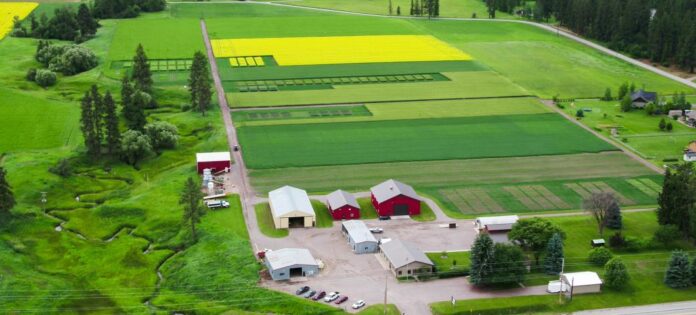BOZEMAN – In the narrow strip of Montana between Flathead Lake and Glacier National Park, just east of Kalispell, there sits a farm that’s easy to drive by without noticing. But those 200 acres, the Northwestern Agricultural Research Center, have been an integral part of fulfilling Montana State University’s land-grant mission for more than 75 years.
Even at that age, NWARC is one of the Montana Agricultural Experiment Station’s younger research centers. One of seven research centers across the state, it was established by the Montana Legislature in 1947 to conduct research tailored to the economy, climate and geography of Flathead, Sanders, Lake and Lincoln counties.
Today, the many acres of cropland and the modern equipment and facilities housed at NWARC primarily explore agronomy and plant responses to stress, including both abiotic — or nonliving — stresses like drought as well as biotic — or living — stresses like insects and disease.
Jessica Torrion is the primary scientist at NWARC and the head of the MSU College of Agriculture’s Department of Research Centers. For nearly a decade, she has conducted research on water management and production of forages and cereals, primarily wheat and barley. Her team has also worked on developing precision management recommendations for producers with the goal of using inputs such as seed, fertilizer and water as efficiently as possible while maximizing production.
“Especially nowadays as people explore new inputs and products, it’s still very important for us to revisit the basics of nutrient management, seed input, seed technology costs and irrigation cost. Those are still the major variables that affect yield and productivity,” Torrion said.
With MSU’s long history of variety development and plant breeding stretching back through nine decades, Torrion said a key element of her research is continually evaluating the scientific recommendations for maximizing yield. A large part of that work involves the time-consuming process of calculating specific data on how various crops and breeds fare under different conditions and growing strategies. When crops are harvested each year, they are weighed and evaluated based on seed size and quantity.
Knowing these specific elements of plant performance and correlating them to such variables as the number of seeds initially planted or the amount of rainfall the field received allows the researchers to fine-tune recommendations about how much seed a producer should plant based on seasonal weather predictions.
“People are used to recommendations in pounds per acre for how much to plant, and a common idea might be that if I plant more, yield will be higher,” said Torrion. “But in reality, we’ve found that planting more is not economical or advantageous to the farmers because the plant has its way of compensating. We have a lot of evidence on those topics. During drought conditions, whether you plant 12 live seeds or 60 live seeds per square foot of wheat, they’ll have the same yield because water is not there.” During a non-drought year, Torrion said, 24 live seeds per square foot is optimal.
Torrion said that around half of the 10 growing seasons she has spent at NWARC have been drought years, allowing her to conduct extensive research under both dry and wet conditions. Much of that work has been supported by funding from the Montana Wheat and Barley Committee and guidance from the NWARC advisory committee, which includes producers who live and work in the counties it serves.
Developing recommendations tailored to a specific part of the state has a very real impact, said Torrion. She conducts research on both industry- and MSU-developed varieties, such as Vida spring wheat, which was the most-planted variety in Montana in 2023 at more than 600,000 acres — more than 20% of the state’s total spring wheat acreage.
While revisiting and refining elemental recommendations about how many seeds to plant or when to water a crop may seem trivial, she said the groundwork research can have a literal payoff for growers.
“Sometimes we can be driven by fear, like if I plant fewer seeds, maybe I won’t yield the same,” Torrion said. “The problem is, if you have a dry spell, you could actually afford to plant less. As you move into drier areas of Montana, you should not be putting a lot more seeds in per unit of ground. And if you save 20 pounds of your seed cost per acre, that can add up to a lot of money.”
NWARC, along with most of MSU’s other research centers, will host its annual summer field day again in 2024. The events are always a highlight of the year, said Torrion, because they let both expert producers and non-agriculturalists learn about the goings-on at the center, ask questions, and make suggestions for future projects.
“Producers really care for research projects that are geographically tailored to the area. It’s a no-brainer that when research is conducted in a similar environment to their area, it’s applicable to them,” said Torrion. “And research is one of the main elements of the land-grant mission—to provide reliable, scientific information on a regular basis to our producers.”




